All about dowels-clamps
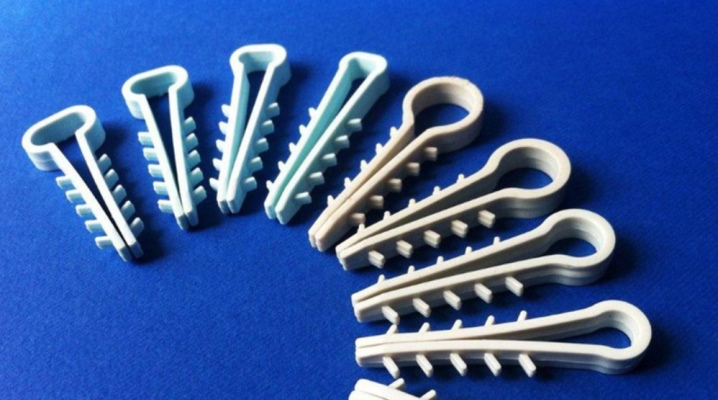
There are many ways to secure the cable. In order not to visually spoil the appearance of the wall or ceiling, not to violate safety rules, among them you must choose the best option. One of these methods is the use of a clamp dowel.
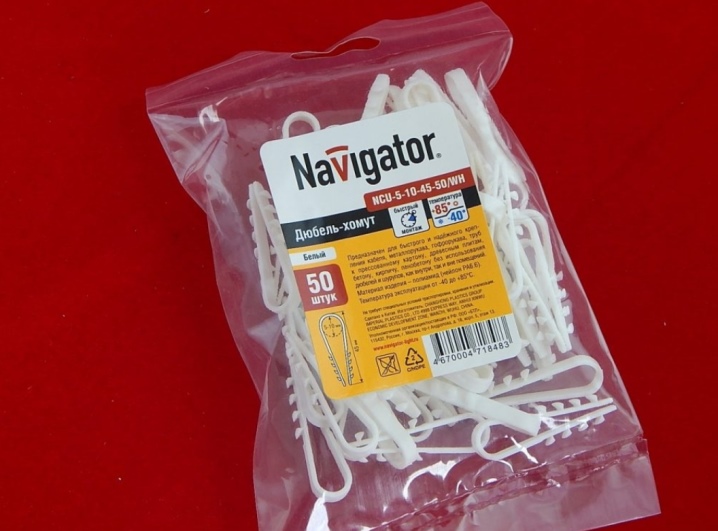
Peculiarities
The dowel-clamp type of fastener appeared on the construction market not too long ago. Due to their functionality, convenience and simplicity, the hardware immediately won recognition from professional electricians. The dowel-clamp is designed for laying and fixing the cable in an open or closed way. It makes it possible to fix the main wiring of cables, wires, thin and flexible pipes to supporting supports made of materials such as concrete, stone, foam concrete, brickwork, as well as to wood or drywall.
- The use of a dowel-clamp allows you to significantly save money in the case when it comes to large volumes - instead of a set of dowel-nail, only one fastening element is used. Due to the same feature, the installation is much faster.
- Plastic hardware, and even more so metal, is able to withstand large temperature changes. Such a wide range allows the use of fasteners both for indoor and outdoor work in almost all regions of the country.
- The material of manufacture is in most cases resistant to ultraviolet rays.
- Fastening elements are capable of holding a large mass, and replacing those that have failed is not difficult.

The dowel clamp also has some disadvantages, although not too serious, compared to a large number of its advantages.
- The material from which the plastic fasteners are made does not burn, but becomes plastic and deforms during a fire.
- Visually, hardware does not look very attractive. But if we consider that the cable itself is not a wall decoration, this drawback of the dowel-clamp can be considered insignificant.
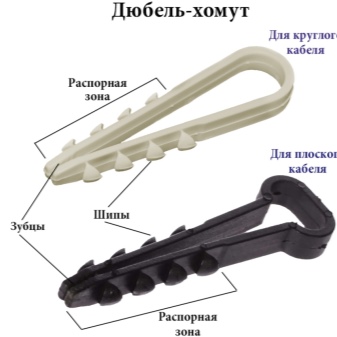
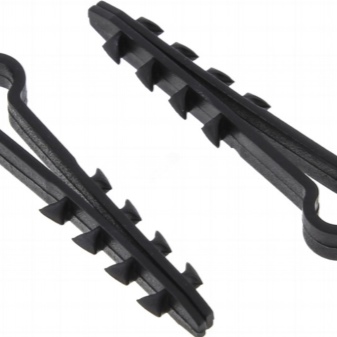
Species overview
This type of hardware is highly specialized, so the assortment, although not too large, is quite sufficient and allows you to make the necessary choice.
The dowel-clamp is a simple bracket made of plastic, on one side of which there is a clamp in the form of a loop, on the other - spacer teeth, it can be round or flattened. Manufacturers produce this type in two color options - black and white, the buyer chooses the color of the wiring. Hardware with a screw is basically a plumbing option. Fire-resistant fasteners have a special polymer coating. In general, fasteners are classified according to different parameters. Let's consider the main ones.
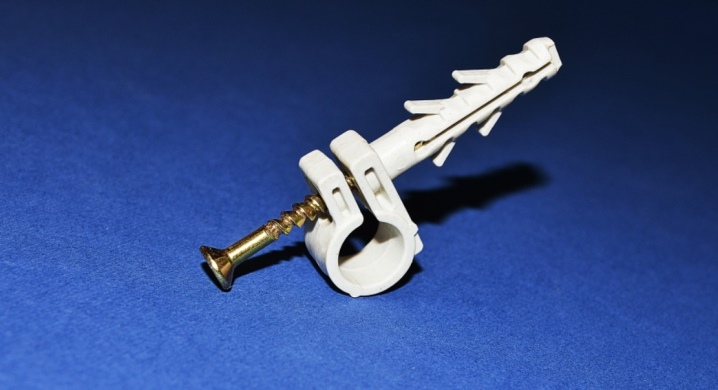
By design
First of all, the dowels-clamps differ in their design features.
- "Bug" - universal fasteners used in many cases. This is a one-leg hardware combined with a metal bracket and a press washer. The use of a "bug" requires monitoring the integrity of the insulation and additional insulation with heat-resistant tape at the joints. The fasteners can support up to 10 kg.
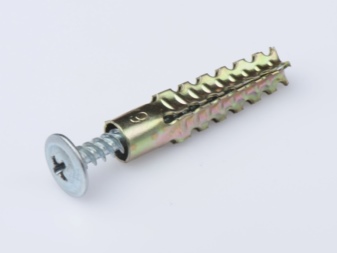
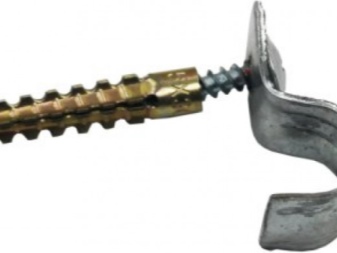
- The round clamp has an expanding or toothed bracket. The flat type is made in the form of a toothed plate with a cable loop. The metal versions are available in brass or zinc steel. In addition, fasteners vary in design.

- Hardware with a wire fire-resistant tape-clamp, coated with polymer. In tandem with the tape, there is a locking device in the form of a buckle, which makes it much easier to fix the line.
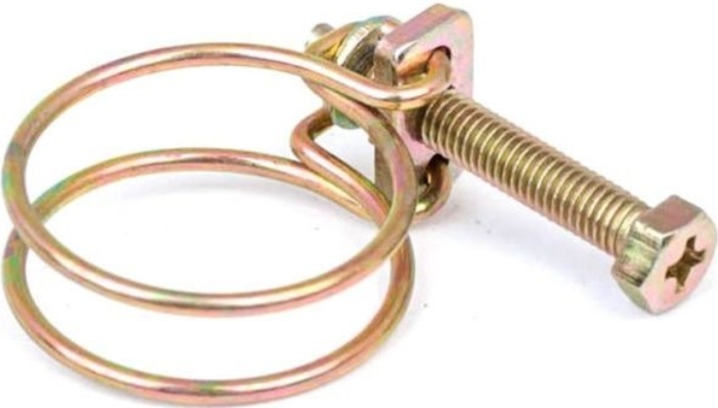
- Brace with counter-groove teeth at the ends. This fastener is used in the process of installing a line with a cross section of 6 to 25 millimeters. Suitable for work with corrugation and electrical wiring, the number of fastened parts depends on the weight of the line.
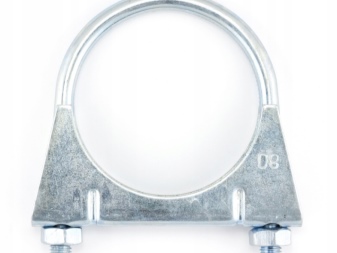

- Complicated view - mounting platform with a clamp. These hardware have a nylon dowel with counter-drifts, at the end of which there is a loop. A clamp is attached to the loop, and the product is fastened. The loop expands the possibilities for mounting corrugations and wires of various diameters.
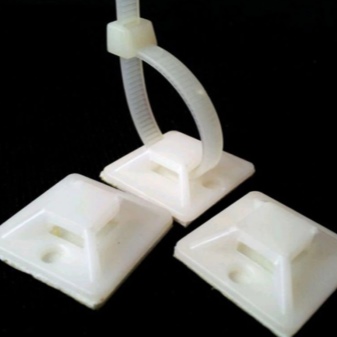

- "Helicopter" - such a name was popularly received by the expansion dowel-clamp. Its open petals are indeed somewhat similar to helicopter propellers. Fastening takes place at the expense of the ends, bursting with a wedge driven in between two petals. The "helicopter" is capable of covering a thin pipe or cable up to 32 mm in diameter. Designed for the use of fasteners with a loop into which the line is inserted, as well as for 8 kg of load, designed for mounting corrugations. It is divided into two more subspecies.
The first subspecies is a one-piece construction, when the rod is already in the dowel. At the same time, the strength of the entire model increases, but the requirements for caution become more stringent, because the dowel is mounted into the wall together with the cable.
In the second variant, the T-shaped fastening hardware has an arc shape without a loop. Hardware of this kind is used to install a cable of a certain size, whose diameter exactly corresponds to the diameter of the arc. This type of spacer is available with one or two arcs, which allows parallel installation.
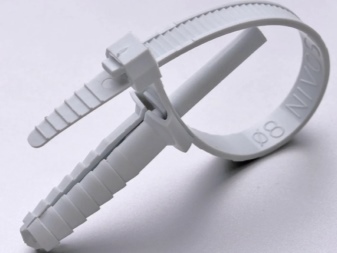

- Plumbing dowel with a clamp screwed onto the screw, consists of two brackets. The staples can be made with a rubber gasket. Optimal solution for handling light pipes with large diameters.
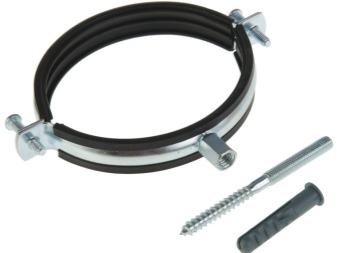
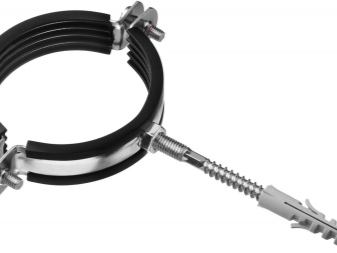
- Clip. It is used for mounting corrugations on a vertical surface. The design is equipped with reinforced latch brackets. Their diameters are 16, 20, 25, 32, 40 and 50 mm.
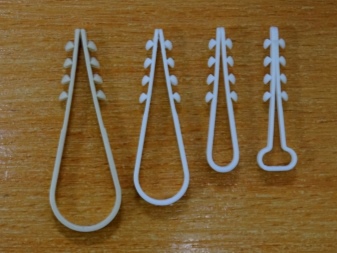
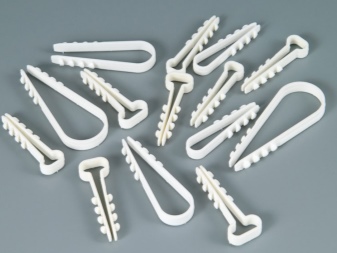
By material
The most demanded and popular type of nylon fastener, due to its high strength. Polyamide components are involved in the production of nylon, they are much stronger than polyester ones, they can withstand temperatures plus 85 degrees Celsius. Ideal for multi-wire backbone routing and fixing. However, fasteners cannot be used in cases where hot piping is to be used.
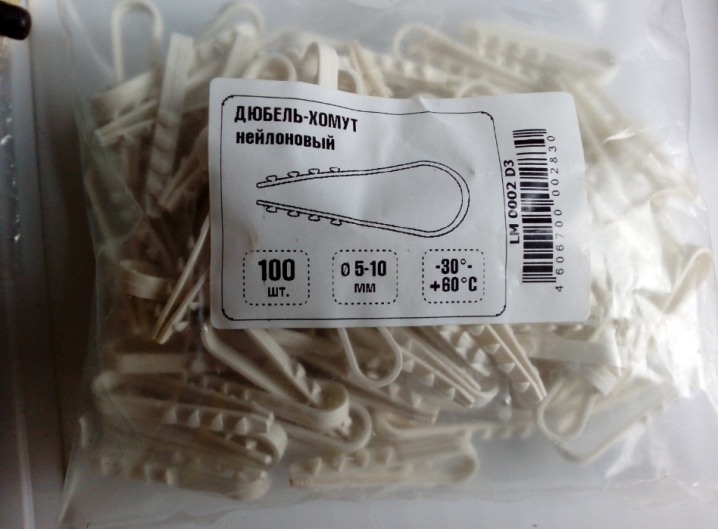
- Polyethylene universal models with a screw made of the most durable material, but are used only indoors, because they do not tolerate exposure to sunlight. Stabilized polyethylene is more durable, but it also becomes brittle over time, and therefore less effective
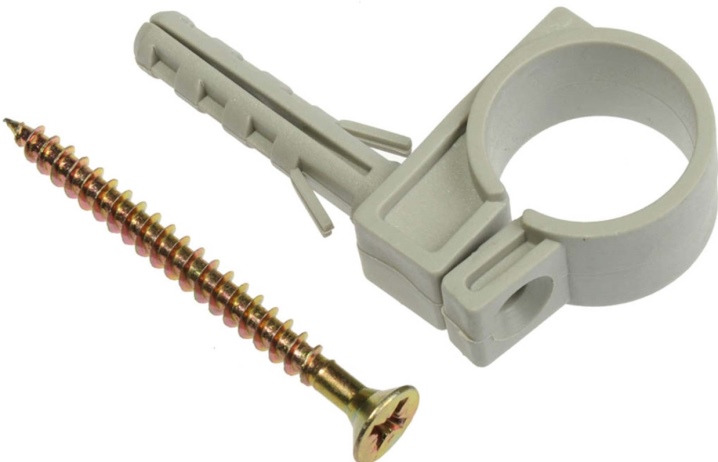
- Metal staples often used as one of the most reliable fasteners. A technological hole is provided in the bracket for fixing with self-tapping screws. The two legs are connected with screws. The lower part is marked with the European diameter designation. Metal or brass products are used when working with hot pipes, for example, in a heating system.

- Metal-rubber hardware made of galvanized steel for clamp, stud or nut and rubber for EPDM gaskets.
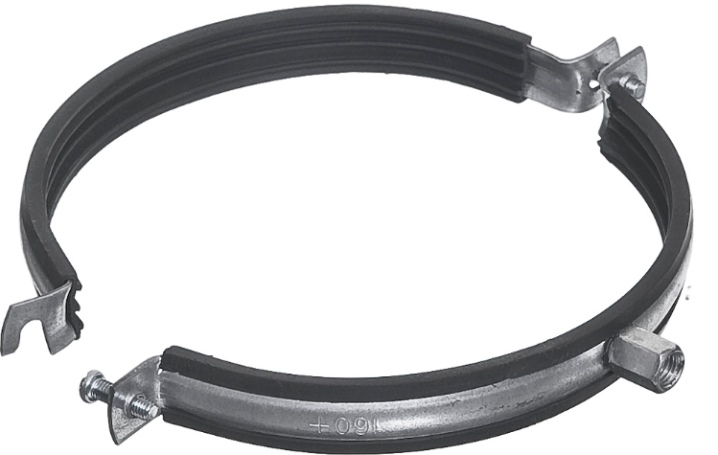
- Clamp strap has a fiberglass-reinforced polymer tape whose task is to fix the bundles of wires. Belt length 140 mm. The strip is used in such a way that through it the self-tapping screw enters the dowel. This type is used for mounting on vertical bearing supports. The tape is capable of supporting a weight of up to 15 kg.
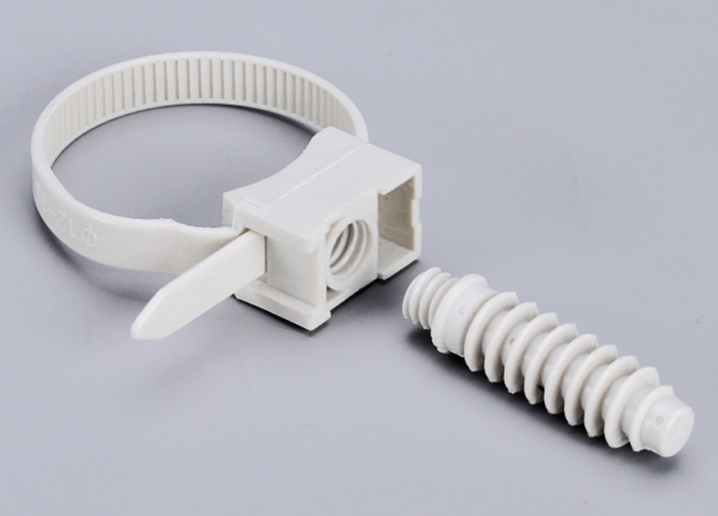
- Polypropylene hardware They are particularly stiff and durable, but unfortunately they are also sensitive to sunlight. But thanks to the stabilizing additives, the UV resistance increases while the cost increases.
Despite the disadvantages of plastic dowels-clamps, they are most often used indoors, which minimizes their sensitivity to UV rays.
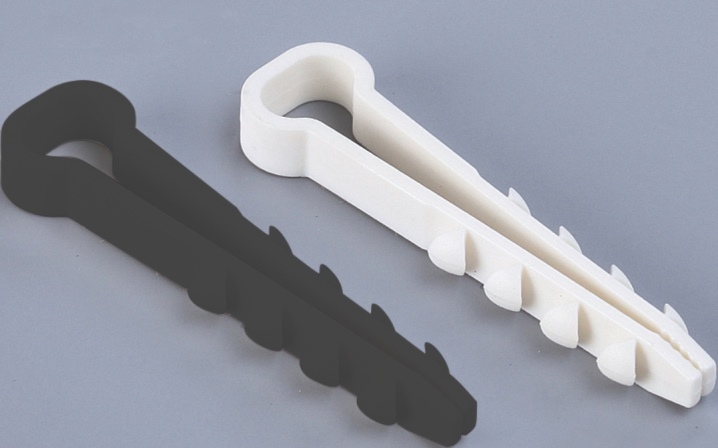
Dimensions (edit)
The most common bracket, which is in the greatest demand for wiring, has standard girth diameters of 5-10, 11-18, 19-25 mm. The required drill diameter with such dimensions is 6 mm, and the minimum immersion depth is 35, 40, 45 mm.
The dimensions of the dowels-clamps are selected depending on the parameters of the cable. For a round cable with a size of 5x10, a clamp size of 5-10 mm is suitable; 11x18 cable needs a clamp 11–18 mm in size. The size of the cable 6x40 will require the purchase of hardware 6–40 mm. Dimensions 6x12; 5x10; 6x17 need, respectively, dowels-clamps 12, 10, 17 mm.
For a flat cable, fasteners of the following sizes are suitable: 19x25, 12x6, 12-6, 32, 14, 6x35, 26, 8, 50, 100x12, 8x45, 20 mm.
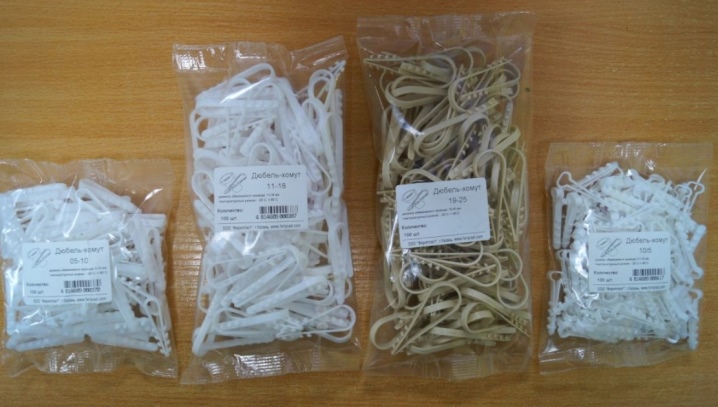
Nuances of choice
To make the right choice of mounting hardware, it is necessary to take into account several parameters: from the diameter and cross-section of the cable, the weight of the future line to the structure of the supporting base. The technical characteristics of metalware-clamps are regulated by the state only in some cases - the clumsy GOST does not have time to respond to the constant updating of specialized mounting fasteners. The buyer should be guided by the accepted European DIN and ISO standards. Fasteners of multicomponent structures have received the GOST 26998-86 regulation.
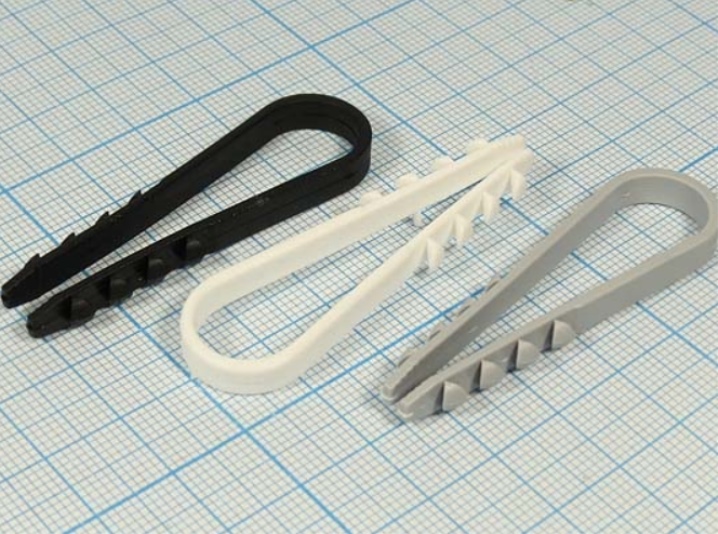
When choosing fasteners, you should use the advice of professionals:
- the anchor type of hardware-clamps is selected according to the required diameter and required length;
- for a cable with a flat section, clamps with a flattened loop are selected;
- for corrugation, the best option is a clip;
- for a pipeline with an increased diameter, a plumbing dowel-clamp with collapsible brackets is selected;
- for multiple trunk lines, a platform with a clamp is ideal;
- if you have to fix the cable on a solid base, a metal "bug" with a one-leg bracket is chosen.
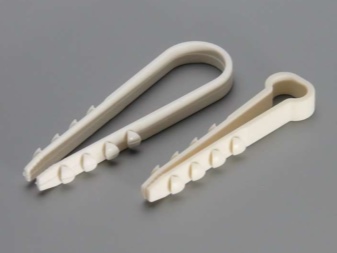
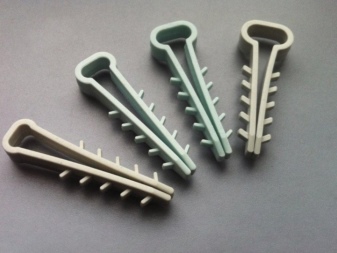
Payment
When calculating the required number of dowels, it is most correct to use the information provided by the manufacturer. The technical manual usually contains the necessary recommendations for the correct method of mounting fasteners. Based on the available parameters, it is easy to calculate the required number of hardware.
The calculation is carried out according to such indicators as the weight of the wiring, which affects one mounting point of fixation, the maximum load that the fastener can withstand, and the distance between the anchor points.
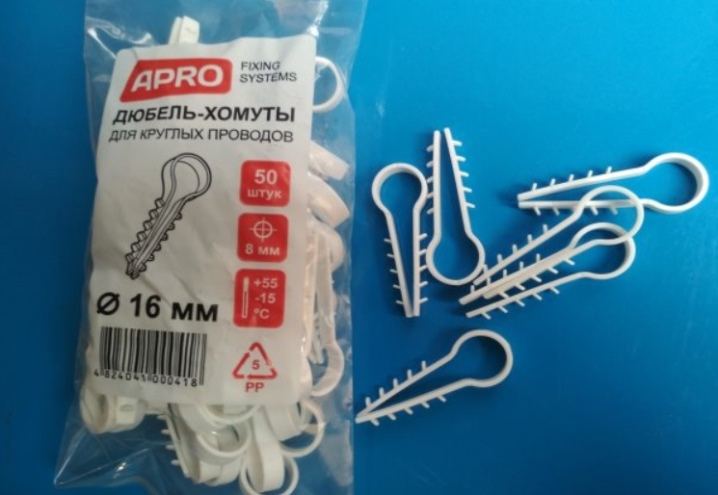
Installation instructions
The installation of dowels-clamps is almost the same as the installation of ordinary dowels - the slight difference is that first a clamp is put on the cable, and then it is carefully hammered into the prepared recess. The drilled hole should match the diameter of the fastener, but the depth is made 10 mm more than the length of the dowel. The maximum distance between the installed fasteners should not exceed 25 cm, for turns - no more than 10 cm.
Each type of fittings has its own installation method. The fixation points are determined taking into account the parameters of the fence, the horizontal and vertical directions of the wiring, the number and radius of corners, the weight of the cable, and the environment. These data are decisive for the optimal choice of the method of how exactly to fix the hardware, their required quantity, installation technology, as well as the wiring and installation schemes.
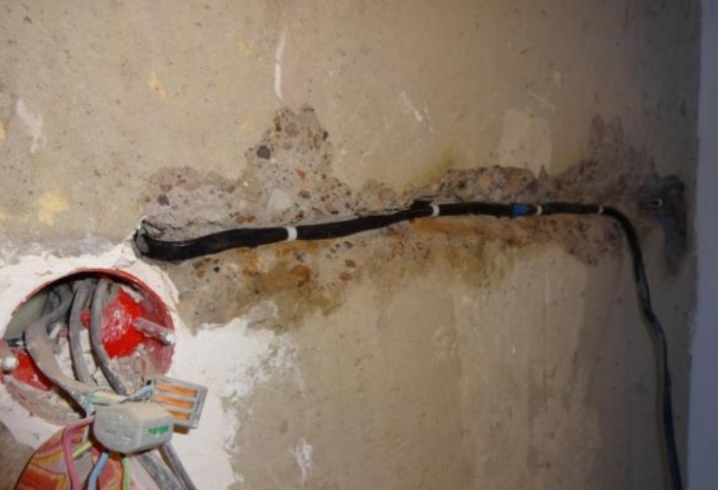
Hidden
The hidden method of trunk laying is used in residential premises if the material of the supporting base allows you to lay grooves. For laying wires in grooves or prepared cable channels, additional installation of dowels-clamps is possible. A single cable is most often fixed with alabaster, but this method is ineffective when it comes to a large specific gravity or a lot of wires. Alabaster successfully replaces clamps that crush a lot of wires into a system group. Often, electricians mark the wiring with tags installed on the screed.In the same way, cables installed in special boxes are fixed.
Installation of a flat cable using a dowel clamp
Using a level and an auxiliary tool such as a cord, points are marked on the wall for fixing the hardware. Drill holes for dowels with an electric drill in advance.
The clamps are fixed in place. The cable body is threaded through the clamp frame, tightening so that there is no sagging.

Fixation on a self-adhesive pad
On painted or varnished surfaces covered with plastic facades, pasted over with wallpaper, you have to use a self-adhesive pad. The base of such a platform is double-sided tape. It must be remembered that the adhesive will "flow" at temperatures above 450 degrees, and at low humidity it will lose its elasticity, the base will dry out, harden and fall off the wall. Self-adhesive pad is the fastest way of installation. The protective film is removed from the back side, the platform itself is forcefully pressed against the surface of the supporting base. A tie is inserted into the grooves of the fastener, with which the wires and cables are fixed.
- Cable clamps. For such a fixation, a general installation plan is drawn up, the attachment points are marked on the surface. The mounting holes are drilled for the dowel fixing points. Clamps are installed taking into account the selected type. They can be fixed with self-tapping screws or screws in a fastening device, inserted into the holes with serrated ends. Anchors are screwed into wooden surfaces.
- The dowel "helicopter" is pre-assembled from two halves, waiting for the final click. The assembled "helicopter" is inserted into the prepared hole, the spacer wedge is carefully driven in. After that, the line is fixed with a loop of the clamp.
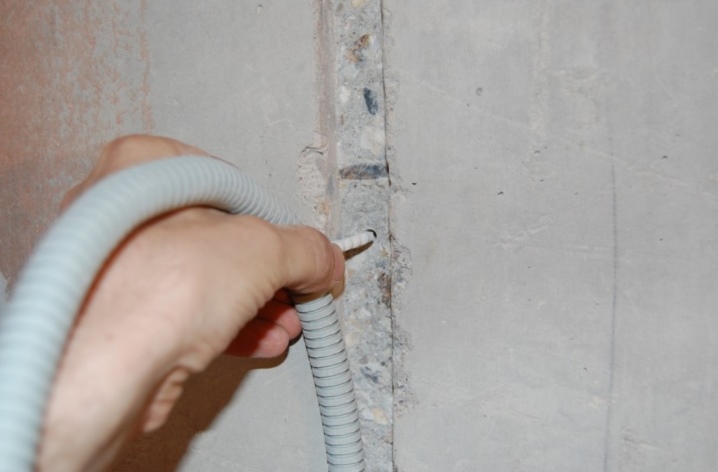
Open
A similar method of laying backbone networks is used in non-residential buildings intended for production or storage.
Fixing the thin cable
In such cases, it is customary to use clamps with a nail. Thin TV and Internet wires are lightweight and do not require a reinforced structure. Small studs installed in clamps do a great job with this.
Clips styling
Clips are used for mounting low-voltage cables on the soft surface of wooden walls. The hardware is fixed to the surface with self-tapping screws, each product has a pair of holes. The cable is pressed into the bracket until it is firmly seated.
- Metal dowel "bug" grips a pipe or cable with a single-leg bracket, fixes it to the surface, then screwed it into a clean drilled hole.
- Sanitary screw clamp pre-dismantled with rubber pads. The dowel is mounted on the wall, after which the bracket is screwed onto the hairpin, the pipe is inserted into it and fixed with the second bracket.
- Dowel clamp with tape. It is quite simple to mount such hardware to the wall - a loop is made from the tape, wires are inserted into it, after which the tape is fixed on the supporting support, the excess ends are cut off.
Having considered all types of dowels-clamps, methods of their installation, you can easily decide on the required type of fasteners and carry out the main wiring.
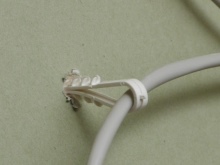

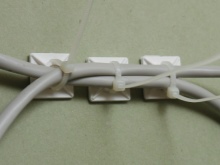
The following video tells about the installation of clamp dowels.













The comment was sent successfully.